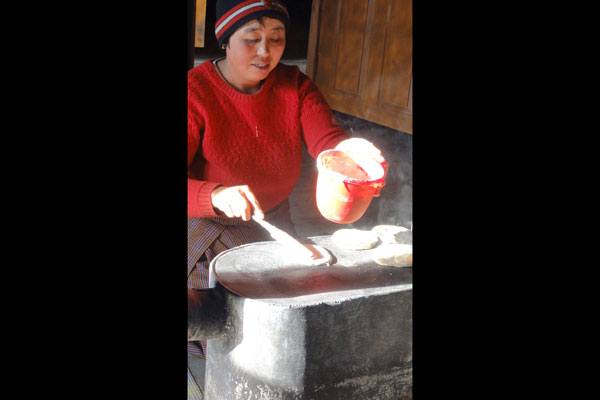by PAM PERRY
For the Sequim Gazette
In the early 2000s, I learned about Bhutan’s policy of Gross National Happiness and became totally obsessed with learning more about a government that truly makes decisions based on what is good for people, culture and environment.
The journey that I will talk about is one that I took in May 2012 on a tour called “Fibers of Bhutan: Culture, Heritage & Arts.” It was designed for people interested in learning more about the weavings and historical traditions of this little known Himalayan kingdom, and while I’m not a weaver myself, I’m intrigued by traditions that are passed down through the generations and the art forms that persist.
Bhutan is a country that makes me feel like I’ve stepped back in time: the first stop light came to the country in 1999 (only three months before it was banished in favor of a human traffic director!), the same year that they got their first dose of American culture on television; and they’ve banned plastic bags and mandated organic farming. It is arguably the most progressive country in the world despite having one of the smallest GDPs.
Seventy-five percent of the population of Bhutanese make their living off the land – selling their goods from cows or gardens at markets, and measure distance in days, not miles.
My recent trip included two nights staying with a family in the rural Haa Valley who were dairy farmers. Their simple life provided food and nice shelter for the family. Their children attend school in the next big town, about a 3-hour bus ride and 2-hour walk.
The other 25 percent (mostly under 30) are living in the cities with many striving for more “Western” style lives including technology, fashion and travel.
In order to visit Bhutan, the government requires that you work with a certified tour operator (like mine, Grand Asian Journeys), ensuring that tourism is well managed and that the dollars that come in from tourism are all being channeled in the appropriate way.
People often talk about how expensive it is to travel in Bhutan, however of the money that you pay to your tour operator (it is required that you work with one) $70 per day goes directly to programs that support the people in the form of health care, education and infrastructure like roads and technology.
I did not travel there the first time until 2010 when I joined a trek to the Jhomolhari Base Camp with a small group. My second trip was in May 2012 (the one I just talked about), and my next journey will be March 15-21, 2014.
If you have ever considered visiting this magical land, I not only highly recommend it as a destination, I highly recommend that you do it as soon as possible.
Much to the government’s chagrin, technology is profoundly changing the culture in Bhutan, especially among the younger generation, and some of the age old traditions are being lost every day.
Though it is changing quickly, I can say without hesitation that Bhutan is by far the most progressive and enlightened country I’ve ever visited!
About the presenter:
Pam Perry, director of operations, Grand Asian Journeys, left a well-paying job in the public relations industry after 15 years to go explore the world on her own. She embarked on a 10-month solo journey around the world to explore places she’d always wanted to visit, discover her roots while meeting her European relatives and immerse herself in learning and contemplation. She knew that the “professional” life of wearing suits and commuting by car was not the road for her!
After returning from that life-changing adventure, she co-founded a company called Grand Asian Journeys to help people explore Asia, her personal favorite region of the world. She’s now spent more than a month exploring Bhutan on two different trips and is preparing for her third trip next month (March 2014). She is passionate about inspiring people to travel!



